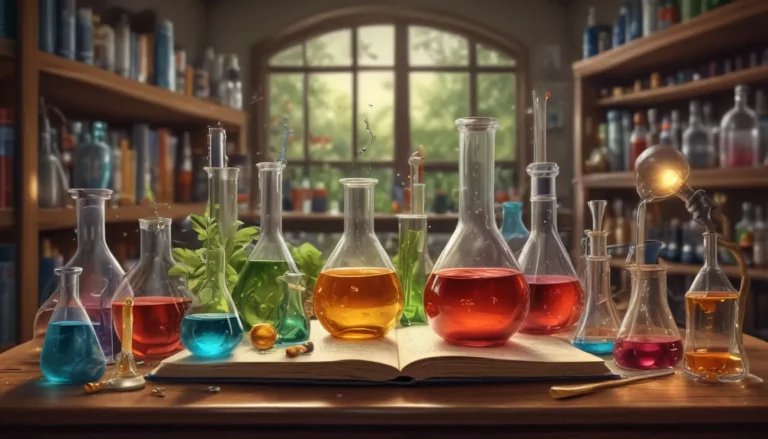A Note About Images: The images used in our articles are for illustration purposes only and may not exactly match the content. They are meant to engage readers, but the text should be relied upon for accurate information.
Welcome to the intriguing world of halogens, a captivating group of elements that have shaped our daily lives and scientific discoveries for centuries. From their essential roles in water treatment and pharmaceuticals to their mesmerizing properties in halogen lamps and industrial applications, halogens continue to astonish us with their versatility and significance.
The Enigmatic World of Halogens
Halogens, including fluorine, chlorine, bromine, iodine, and astatine, comprise a unique family of elements known for their distinct characteristics and reactivity. Their electronic configuration with seven valence electrons gives them a strong affinity for electron gain, making them highly reactive and essential in various chemical processes.
Exploring the Fascinating Facts About Halogens
Halogen Lamps Brightening Up the World
- Halogen lamps emit intense white light, making them a popular choice for bright illumination in various applications.
- They provide crisp, clear lighting essential for tasks that require high visibility.
Halogens in Water Treatment and Health
- Chlorine, a crucial halogen element, is widely used in water treatment to disinfect and purify water, ensuring safe drinking water for millions.
- Iodine, another vital halogen, plays a key role in the production of thyroid hormones essential for metabolism and overall health.
Halogens in Flame Retardants and Fire Safety
- Brominated flame retardants containing bromine, a halogen element, are commonly utilized in electronics, textiles, and furniture to reduce the risk of fire.
- These compounds help slow down the spread of flames and contribute to increased fire safety in various settings.
Halogens in Energy-Efficient Lighting Solutions
- Halogen bulbs offer a more energy-efficient lighting option compared to traditional incandescent bulbs, consuming less electricity while providing similar quality of light.
- Their efficient design makes them a greener choice for environmentally conscious consumers.
Halogens in Pharmaceuticals and Industrial Applications
- Halogenated organic compounds are extensively used in the pharmaceutical industry to enhance the effectiveness and stability of drugs, contributing to advancements in medicine.
- Halogens find diverse applications in various industrial processes, such as PVC production, flame retardants manufacturing, and dye production.
Halogens’ Vibrant Colors and Chemical Reactions
- Each halogen exhibits distinct colors in its gaseous state, with chlorine appearing greenish-yellow, bromine displaying a reddish-brown hue, and iodine presenting a purple vapor.
- Halogens’ reactivity allows them to form compounds with metals, resulting in metal halides with applications in photography, laboratory reagents, and catalysis.
Halogens and Environmental Impact
- Halogens, particularly chlorine and bromine, have been associated with ozone depletion in the atmosphere, emphasizing the importance of responsible handling and disposal of halogen-containing compounds.
- Minimizing their environmental impact is crucial to preserving the health of our planet and ecosystem.
A Glimpse Into Halogenation, Astatine, and Alkyl Halides
Halogenation: The Creation of New Compounds
- Halogenation is a fascinating process where halogens combine with other elements to form new compounds with unique properties and applications.
- This chemical reaction opens up a realm of possibilities for creating innovative materials and enhancing existing products.
Astatine: The Rarest Earth Element
- Astatine, the rarest naturally occurring element on Earth, holds its own mysteries and potential for groundbreaking discoveries.
- Its scarcity and unique properties make it a subject of fascination and intrigue in the scientific community.
Alkyl Halides: Organic Compounds with Remarkable Attributes
- Alkyl halides, a class of organic compounds containing halogens, exhibit incredible properties and functionalities with diverse applications.
- Their composition and characteristics make them essential building blocks in organic chemistry and industrial processes.
Conclusion: Embracing the Marvels of Halogens
In conclusion, halogens are not just elements on the periodic table; they are an intrinsic part of our daily lives, scientific advancements, and industrial progress. From illuminating our world with bright light to safeguarding our health and environment, halogens play a crucial role in shaping our society and enhancing our well-being. As we delve deeper into the realm of chemistry, let us continue to appreciate the wonders of halogens and their enduring impact on our world.
FAQs: Your Questions Answered
Q: What are halogens?
A: Halogens are a group of chemical elements known for their reactivity and diverse applications, including fluorine, chlorine, bromine, iodine, and astatine.
Q: What are some common applications of halogens?
A: Halogens are used in water treatment, pharmaceuticals, flame retardants, lighting, and various industrial processes due to their unique properties and reactivity.
Q: Are halogens harmful to humans?
A: While halogens are essential for biological processes in small quantities, excessive exposure to halogen compounds can have adverse health effects and should be handled with care.
Q: Can halogens be found in nature?
A: Halogens can be found in nature in various forms, often in compounds rather than in their pure elemental states, with chloride ions abundant in seawater and iodine present in seaweed.
Q: How do halogens react with other elements?
A: Halogens are highly reactive and tend to form compounds with metals, resulting in ionic compounds known as halides with diverse applications in chemistry and industry.
Q: What are the physical properties of halogens?
A: Halogens exist as diatomic molecules in their elemental form, with fluorine and chlorine as gases, bromine as a liquid, and iodine as a solid, each exhibiting distinct colors and characteristics.
Explore the captivating world of halogens and unlock a realm of endless possibilities and discoveries! As you embark on this enlightening journey, remember to appreciate the remarkable contributions of halogens in our lives and industries. Let their power and versatility inspire you to explore the limitless potential of these extraordinary elements.






